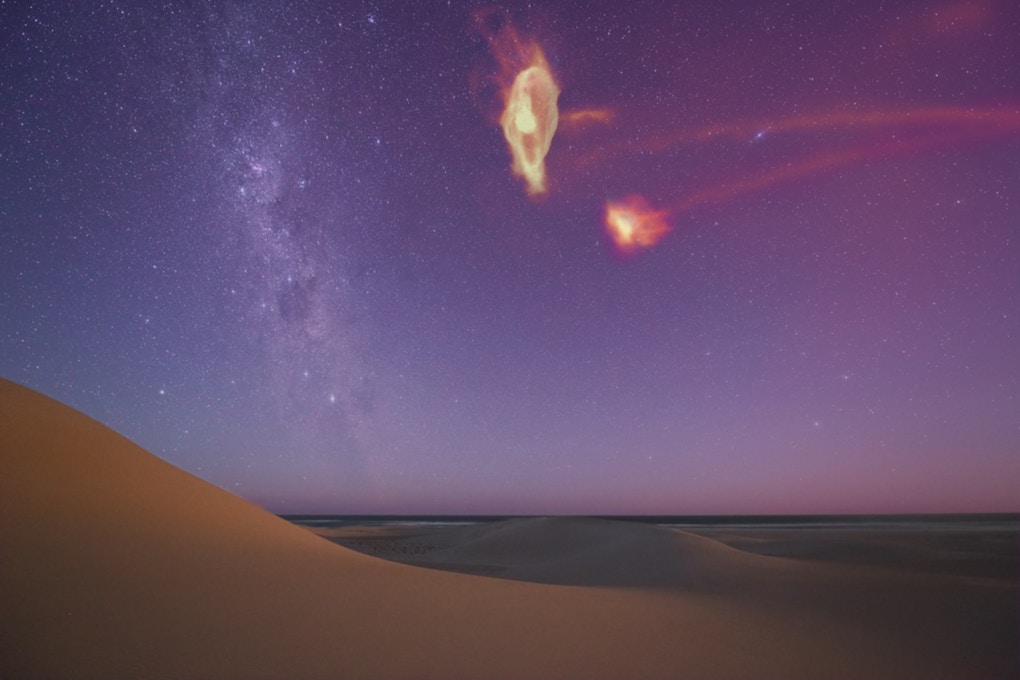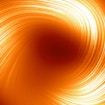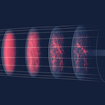Massive Halo Finally Explains Stream of Gas Swirling Around the Milky Way

The Milky Way is not alone in its neighborhood. It has captured smaller galaxies in its orbit, and the two largest are known as the Small and Large Magellanic Clouds, visible as twin dusty smears from the Southern Hemisphere.
As the Magellanic Clouds began circling the Milky Way billions of years ago, an enormous stream of gas known as the Magellanic Stream was ripped from them. The stream now stretches across more than half of the night sky. But astronomers have been at a loss to explain how the stream became as massive at it is, over a billion times the mass of the sun.
Now, astronomers have discovered that a halo of warm gas surrounding the Magellanic Clouds likely acts as a protective cocoon, shielding the dwarf galaxies from the Milky Way’s own halo and contributing most of the Magellanic Stream’s mass. As the smaller galaxies entered the sphere of the Milky Way’s influence, parts of this halo were stretched and dispersed to form the Magellanic Stream. The researchers report their findings September 9 in the journal Nature.
“The existing models of the formation of the Magellanic Stream are outdated because they can’t account for its mass,” says study first author Scott Lucchini, a graduate student at the University of Wisconsin–Madison.
“That’s why we came out with a new solution that is excellent at explaining the mass of the stream, which is the most urgent question to solve,” adds Elena D’Onghia, a professor of astronomy at the University of Wisconsin–Madison who led the work as a visiting scholar at the Flatiron Institute’s Center for Computational Astrophysics in New York City.
D’Onghia and Lucchini collaborated with physicists and astronomers at the University of Wisconsin–Madison, the Space Telescope Science Institute and the University of Sydney.
Older models suggested that gravitational tides and the force of the galaxies pushing against one another formed the Magellanic Stream out of the Magellanic Clouds as the dwarf galaxies came into orbit around the Milky Way. While these models could largely explain the stream’s size and shape, they accounted for just a tenth of its mass.
Recently, astronomers discovered that the Magellanic Clouds are massive enough to have their own halo, or corona, of warm gas enveloping them. D’Onghia and her team realized this corona would dramatically alter how the stream formed.
In new simulations carried out by Lucchini, the creation of the Magellanic Stream is divided into two periods. While the Magellanic Clouds were still far away from the Milky Way, the Large Magellanic Cloud stripped gas away from its smaller partner over billions of years. This stolen gas ultimately contributed 10 to 20 percent of the final mass of the stream.
Later, as the clouds fell into the Milky Way’s orbit, the corona gave up a fifth of its own mass to form the Magellanic Stream, which was stretched across an enormous arc of the sky by interactions with the Milky Way’s gravity and its own corona.
The new model is the first to explain the full mass of the Magellanic Stream and the vast majority that comes from ionized gas, which is more energetic than non-ionized gas. It also better explains how the stream adopted its filamentous shape and why it lacks stars — because it was formed largely from the star-free corona, not the dwarf galaxies themselves.
“The stream is a 50-year puzzle,” says Andrew Fox, an astronomer at the Space Telescope Science Institute in Baltimore, MD, which operates the Hubble Space Telescope, and one of the co-authors of the study. “We never had a good explanation of where it came from. What’s really exciting is that we’re closing in on an explanation now.”
The researchers’ proposal can now be directly tested. The Hubble Space Telescope should be able to see the tell-tale signatures of the corona of gas surrounding the Magellanic Clouds. If confirmed, the findings will help explain a half-century mystery about the origin of the stream, offering a fuller picture of our galactic neighborhood.
In the 1990s, a group of astronomers at UW–Madison found the first hints that the Magellanic Clouds might have an extensive corona. Now with a better understanding of the corona’s influence on the Magellanic Stream and a clear-cut test for its existence, there’s a chance to settle a decades-long question.
“This work redefines our understanding of how gas accretes onto the Milky Way and forms the reservoir for future star formation” says Joss Bland-Hawthorn, a co-author of the paper and director of the Sydney Institute for Astronomy in Australia.


